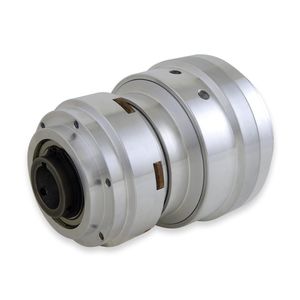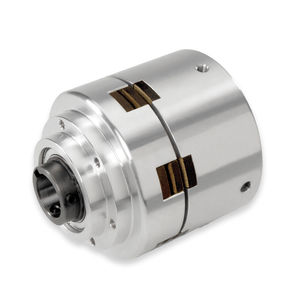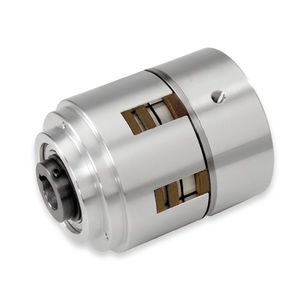
- Products
- Catalogs
- News & Trends
- Exhibitions
NEMA combined clutch-brake unit STH Seriesfrictionpneumaticspring

Add to favorites
Compare this product
Characteristics
- Type
- friction
- Operation
- pneumatic, spring
- Other characteristics
- NEMA
- Torque
Min.: 16.41 ft.lb
Max.: 86 ft.lb
- Rotational speed
1,750 rpm
(10,995.57 rad.min-1)
Description
NEMA FRAME CLUTCH-BRAKES
Combination Air Applied Clutch and Spring Applied Brake
Function: Starting and Stopping / Holding The Output Shaft
Drive Arrangement: Motor to Gear Reducer (or Output Shaft Mounted Component)
One air signal is required.
Clutch torque transmitted is proportional to the amount of air pressure applied, brake torque is a fixed value.
Operation
Applying air pressure releases the spring applied friction brake and engages the friction clutch.
Torque of the clutch is linear in response to air pressure applied above the brake release pressure.
Brake torque is fixed by spring pressure.
Mounting
Clutch Brake mounts between a c-face motor and gear reducer.
or, Mounts to motor with a pulley or sprocket on the output shaft (see Detail Sheet for overhung load capacity).
Clutch Brakes are designed for horizontal mounting. Consult engineering if vertical mounting is required.
Applications
Start/Stop, Cycling, Indexing.
Maximum RPM varies by model and is listed on the PDF detail sheet (see table below). Consult engineering if the intended application exceeds the listed maximum RPM.
Design Features
Clutch and brake combined in one unit for simplified mounting and control.
Models listed have enclosed, aluminum housings.
Clear anodized and stainless housing are also available. If needed, please contact engineering.
Suitable for belt or chain drive (sprocket or pulley) applications.
Catalogs
No catalogs are available for this product.
See all of Mach III Clutch, Inc.‘s catalogsRelated Searches
- Friction brake
- Spring brake
- Friction clutch
- Overload clutch
- Safety brake
- Pneumatic brake
- Spring activated brake
- Spring clutch
- Failsafe brake
- Pneumatic clutch
- Mechanical overload clutch
- Friction slip clutch
- Motor brake
- Multiple-disc clutch
- Multiple-disc brake
- Safety torque limiter
- Adjustable brake
- Combined clutch-brake unit
- Friction combined clutch-brake unit
- Brake with pneumatic release
*Prices are pre-tax. They exclude delivery charges and customs duties and do not include additional charges for installation or activation options. Prices are indicative only and may vary by country, with changes to the cost of raw materials and exchange rates.





